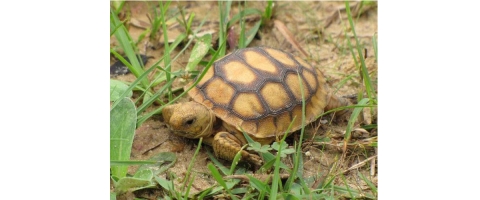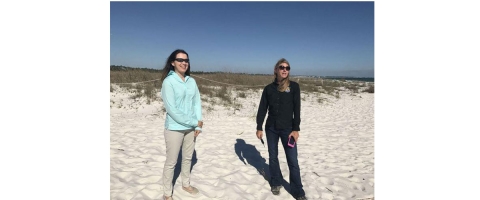Panama City, Florida – Melanie Kaeser is embedded with the military at Tyndall Air Force Base. She patrols the pine forests and swampy wetlands as F-16s and F-22s maneuver overhead.
Her mission: protect those in harm’s way – the gopher tortoises, the St. Andrews Beach mice and the Godfrey’s butterworts.
Kaeser is a U.S. Fish and Wildlife Service ecologist on detail to the U.S. Air Force. She’s in the vanguard of a growing civilian-military relationship to protect threatened and endangered species while allowing the war fighters to keep training with fewer regulatory obstacles.
Currently, seven Service scientists are embedded on four Air Force installations across Florida. The numbers will double by the end of the next fiscal year.
The “biologists on bases” program is part of the congressionally mandated Sikes Act which requires the services to protect natural resources, including threatened and endangered species. It’s also another tool the military use to maintain readiness and training while adhering to federal environmental rules.The Service and the Defense Department recently created a groundbreaking gopher tortoise credit program that provides more flexibility for the military to continue its training mission across the Southeast with fewer regulatory roadblocks.
“We’re an odd couple, but – big picture – the military mission and the U.S. Fish and Wildlife Service mission are perfectly aligned,” said Catherine Phillips, who runs the Service’s Panama City office, as well as the biologist program with the Air Force. “Our mission is to help the military reach its natural resource targets which, consequently, lessens the military’s regulatory burden.”
Installations, surprisingly, are perfect locales for Service biologists to target endangered wildlife. Amidst artillery fire and tank maneuvers, many bases nonetheless serve as “islands of biodiversity,” according to Kevin Porteck, a civilian natural resources expert at Lackland Air Force Base in San Antonio, Texas. Untouched by urban sprawl or expansion-minded farmers, bases with tens of thousands of acres remain locked in decades-old time warps where plants and animals flourish.
“It just so happens we have the biodiversity other landowners are envious of,” said Porteck. “But therein lies the challenge: how do you allow military missions to occur while simultaneously complying with all laws to protect threatened and endangered species? It’s a balancing act to which we have been fairly successful.”
Never a dull moment
Kaeser wants to burn Tyndall down. Not all of it. Maybe 7,000 acres of slash pine, about one-fourth of the air base that lies just east of Panama City. But first she wants the pine harvested and replaced with longleaf – the long-living, habitat-nurturing, fire-friendly tree prized by conservationists and gopher tortoises alike.
Kaeser, along with Daniel Childs, Tyndall’s forester, harvest 450 acres each year of slash pine and replace it with longleaf seedlings. Fish and Wildlife’s goal is to restore as much of the South’s longleaf pine habitat, which once covered 90 million acres from Virginia to Texas, as possible. (Less than five million acres remain.) Controlled burns, every two years, will thin the canopy, let the sun shine through and rejuvenate the grasses and legumes favored by gopher tortoises and the 350 other species which avail themselves of the tortoise’s burrow.
Tyndall’s already lush understory, as well as its 18-mile-long beach and dune system, is home to 27 federal- or state-protected species, including the St. Andrews beach mouse and the green sea turtle. An additional 23 plants, including the gulf purple pitcher plant, are on the at-risk list.
“Restoring this ecosystem will be beneficial for all those species, especially with frequent, prescribed fires and an open canopy like this one here,” said Kaeser, traipsing through a newly planted longleaf pine stand. “Tyndall has a lot of promise, but there’s a lot of restoration work that needs to be done. There’s never a dull moment.”
The Service employs two other biologists on Tyndall who monitor the mouse as well as the gopher tortoise and sea turtles.
Protect species, military
Tyndall was nothing but sand, swamp, palmetto and pine trees in 1941 when the local congressman suggested the under-construction base be named for a World War I flying ace. Then-U.S. Rep. Bob Sikes, the powerful Panhandle politician, chaired a House military appropriations committee that funnelled billions of dollars to Florida bases. At one time, Sikes’ district boasted 14 installations.
In 1960, Congress established the Sikes Act, which mandated cooperation between the Defense Department, the Service and state agencies to protect natural resources on military installations nationwide. The law was amended in 1997 requiring the military to develop detailed environmental, cultural and recreational management plans while guaranteeing military readiness. At Tyndall, for example, the 325th Fighter Wing can soar the skies as long as the gopher tortoise is protected on (or below) the ground.
“We need natural resource professionals to protect habitats and species and Fish and Wildlife has that expertise,” said Porteck. “Military installations are for military purposes, however they also happen to be islands of biodiversity. We have more sensitive species on our bases than most federal agencies have on their lands.”
The Defense Department manages nearly 30 million acres on 425 bases nationwide. More than 400 threatened or endangered species live on bases – on par or greater than the number living in the National Park System, which has nearly three times as much land.
The Defense Department and the Service point to numerous at-risk success stories. In 1973, for example, the Okaloosa darter was added to the endangered species list. Nearly all of the tiny fish call Eglin Air Force Base, in nearby Valparaiso, Fla., home. Restoring streams on base to a more natural condition helped the darter get downlisted to the threatened list in 2010.
Eglin, along with Fort Bragg (in North Carolina) and Stewart and Benning (in Georgia), tally about a third of the remaining pairs of endangered red-cockaded woodpeckers. Recovery of the gulf sturgeon, reticulated flatwoods salamander, piping plover and various turtles and mussels is also underway at Eglin. “We have a large amount of listed and at-risk species compared to other states and we also have a large number of bases in Florida,” said the Service’s Phillips. “And in Florida, with large amounts of development, bases can often be the last places with untouched habitat.”
The Pentagon covers the program’s costs, about \$4.3 million for fiscal 2018, which includes habitat restoration and the control of invasive species invasive species
An invasive species is any plant or animal that has spread or been introduced into a new area where they are, or could, cause harm to the environment, economy, or human, animal, or plant health. Their unwelcome presence can destroy ecosystems and cost millions of dollars.
Learn more about invasive species . Currently, seven biologists, ecologists or biotechs are embedded at four bases. Phillips expects to double the number of scientists deployed across seven of Florida’s eight Air Force installations by the end of the upcoming fiscal year. (Homestead Air Reserve Base isn’t participating in the program.)
“Give the Air Force a target,” Phillips said, “and they’ll hit it.”







